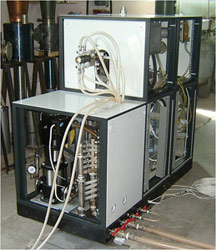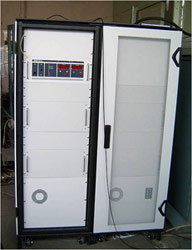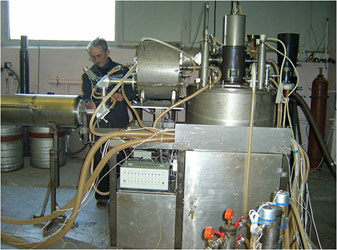 |
|
Continuous-wave (CW) gyrotrons
First Russian continuous-wave technological gyrotrons were developed and produced at IAP in the 1970s. Innovative developments were also performed in the vacuum electronics division of the Research & Production Enterprise "Salut". Since its establishment in 1992, GYCOM Ltd. has been following the traditions of gyrotron manufacture. It also developed and commercialized several series of devices and corresponding complexes operated in the frequency range from 24 to 300 GHz. In 20 years, GYCOM Ltd. has manufactured over 30 CW gyrotron systems and delivered them to Russian and foreign customers.
Classical CW gyrotrons work at the second gyrofrequency harmonic in oil-cooled solenoids. As shown in Figure. 1, the energy output in such devices is arranged in the form of the working waveguide mode, along the longitudinal axis of the device. A typical operating frequency lies within the band from 24 to 30 GHz, the voltage does not exceed 25 kV, and the cathode current does not exceed 2.5 A. Usually, the output power of such systems does not exceed 25 kW. Their advantages are simplicity, mobility, and fast actuation time. Their drawbacks are limitations of the operating frequency and power, as well as the great power cost of magnetic field production in a warm solenoid.
The advance in increasing of the operating frequency, output power, and efficiency of gyrotrons was made in the 1990s due to the transition to operation at the first gyrofrequency harmonic in superconducting solenoids. In recent years, GYCOM Ltd. has developed a series of technological gyrotrons with efficient quasioptical converters of the working waveguide mode to the Gaussian wave beam and recuperation of the residual energy of the electron beam (see Fig. 2). In terms of their design, such gyrotrons differ from modern gyrotrons for controlled-fusion setups by smaller dimensions of the cathodes and electron collectors, as well as the material of the energy output window. The maximum power is determined by the throughput capacity of the energy output, which is made of boron nitride, and amounts to 40-50 kV depending on the operating frequency. The main power supply has an output voltage of not more than 30 kV and a current of not more than 4 A. The gyrotrons employ water cooling systems with water consumption of about 4 l/s under a pressure of 3 atm. The total efficiency of the system if 45%-50%.
Usually, technological gyrotrons are supplied to customers as components of gyrotron complexes, which contain all the necessary equipment: a (cryo)magnet, matching optic units, microwave transmission lines, coupled calorimetric loads, high-voltage and other power supplies, water cooling systems, and protection and control systems. Figures 3-4 show assembled gyrotron complexes based on various gyrotrons. Power supplies are shown in Fig. 5.
|
|
|

|
|

|
|
|
|
|
List of CW gyrotrons supplied by GYCOM and used in customers' facilities
Name and location of the facility |
Gyrotron parameters |
Year of delivery |
Number of gyrotrons |
CCU NSU, Russia |
24 GHz, 5 kW, CW |
2009 |
1 |
IAP RAS, Russia |
263 GHz, 1 kW, CW |
2015 |
1 |
| |
170 GHz, 20 kW, CW |
2021 |
1 |
IFP, Italy |
28 GHz, 15 kW, CW |
2008 |
1 |
IN2P3, France |
28 GHz, 10 kW, CW/pulse |
2003 |
1 |
FZK, Germany |
30 GHz, 10 kW, CW |
1994 |
1 |
30 GHz, 15 kW, CW |
2000 |
1 |
GSI mbH,Germany |
28 GHz, 10 kW, CW |
2007 |
1 |
|
258 GHz, 0.1 kW, CW |
2008 |
1 |
KIT, Germany |
30 GHz, 15 kW, CW |
2010 |
1 |
FIR, Japan |
24 GHz, 3 kW, CW |
2001 |
1 |
24 GHz, 2.5 kW, CW |
2006 |
1 |
28 GHz, 15 kW, CW |
2006 |
1 |
Osaka Univ.,Japan |
24 GHz, 3 kW, CW |
2003 |
1 |
24 GHz, 3 kW, CW, perm. magnet |
2004 |
2 |
Fuji Dempa, Japan |
28 GHz, 3 kW, CW |
2003 |
1 |
Alloy Industries Inc., Japan |
28 GHz, 10 kW, CW |
2004 |
1 |
Kinki Univ., Japan |
24 GHz, 3 kW, CW |
2005 |
1 |
Shimane Ins., Japan |
24 GHz, 3 kW, CW |
2005 |
1 |
|
300 GHz, 4 kW, CW |
2005 |
1 |
Isman J Corp.,Japan |
24 GHz, 3 kW, CW |
2006 |
1 |
Tohoku Univ., Japan |
24 GHz, 3 kW, CW |
2006 |
1 |
Okayama Univ., Japan |
24 GHz, 3 kW, CW |
2007 |
1 |
Shirai Tech. Corp.,Japan |
82 GHz, 30 kW, CW |
2007 |
1 |
IAPh CAS, China |
30 GHz, 10 kW, CW |
1998 |
1 |
IMP CAS, China |
24 GHz, 7 kW, CW |
2009 |
1 |
| |
45 GHz, 20 kW, CW |
2017 |
1 |
SWUST, China |
83 GHz, 25 kW, CW |
2010-2011 |
2 |
LANL, USA |
83 GHz, 20 kW, CW |
1993 |
2 |
37.5 GHz, 20 kW, CW |
1993 |
1 |
30 GHz, 10 kW, CW |
1996 |
1 |
Sandia NL, USA |
30 GHz, 10 kW, CW |
1996 |
1 |
General Atomic, USA |
30 GHz, 10 kW, CW |
1997 |
1 |
CRS, USA |
83 GHz, 15 kW, CW |
1998 |
1 |
Gyrotron Tech. Inc., USA |
83 GHz, 15 kW, CW |
1999 |
1 |
60 GHz, 35 kW, CW |
2011 |
1 |
Guardian Ind., USA |
83 GHz, 35 kW, CW |
2003 |
1 |
NRL, USA |
83 GHz, 15 kW, CW |
2004 |
1 |
Thor Technologies, Inc. , USA |
24 GHz, 5 kW, CW |
2006 |
1 |
Michigan Univ., USA |
24 GHz, 5 kW, CW |
2011 |
1 |
Gyrotron Tech.Inc., USA |
60 GHz, 35 kWт, СW |
2015 |
1 |
|
|











